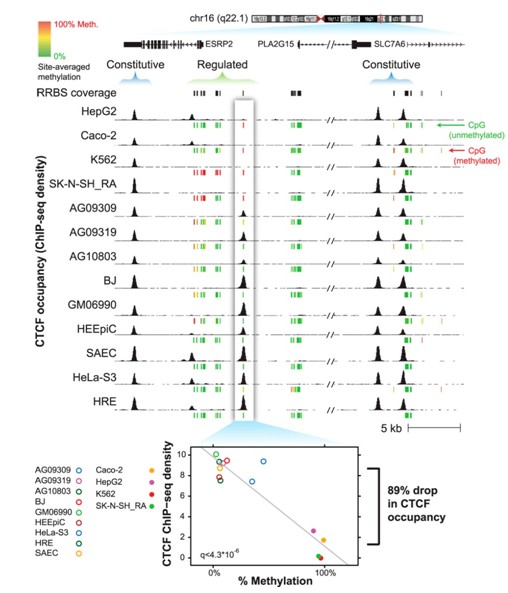A Link Found Between Variable CTCF Occupancy and DNA Methylation
CTCF is a ubiquitously expressed regulator of fundamental genomic processes including transcription, intra- and interchromosomal interactions, and chromatin structure. CTCF binding patterns are widely believed to be largely invariant between cell types and linked with DNA methylation in vivo at a small number of loci. Recently, a link of variable CTCF occupancy to DNA methylation on a global scale was demonstrated by a team led by Dr. John A. Stamatoyannopoulos, associate professor of genome sciences and medicine at the University of Washington. Dr. QU Hongzhu from Beijing Institute of Genomics(BIG), Chinese Academy of Sciences participated in this work.
To study the relationship between CTCF occupancy and DNA methylation systemically, the researchers first localized and quantified CTCF occupancy by ChIP-seq in 19 diverse cell lines, including seven immortal cell lines and 12 normal cell types. They observed highly reproducible yet surprisingly plastic genomic binding landscapes that were markedly different in normal versus immortal cells, indicative of strong cell-selective regulation of CTCF occupancy. Comparing CTCF occupancy with massively parallel bisulfite sequencing data in 13 cell lines, they detected that 41% of variable CTCF binding showed a significant association with differential DNA methylation. At significant sites, increased methylation was negatively associated with occupancy in 98% of cases (see figure below). Sites of differential methylation associated with occupancy differences were further observed an enrichment of CpG dinucleotides at two positions in the CTCF recognition sequence.
Although experimentally directed methylation can prevent binding of CTCF and other factors in vitro, the mechanisms establishing methylation patterns in vivo remain unknown. The results in this research do not distinguish whether demethylation facilities subsequent CTCF binding or whether bound CTCF maintains an unmethylated domain. Dr. Wang has pointed that “An alternative model has DNA methylation deposited passively in the wake of independent abrogation of transcription factor binding. CTCF has a limited capacity to directly affect methylation while methylation perhaps acts as a cooperative switch to prevent the return of CTCF after a reprogramming event.” In this model, methylation is a general amplifier of perturbations to transcription factor occupancy.

Impact of DNA methylation on cell-selective CTCF binding (Image by Stamatoyannopoulos' Lab )
Paper link: http://genome.cshlp.org/content/22/9/1680
Contact: Prof. John A. Stamatoyannopoulos,
Email: jstam@u.washington.edu
Dr. QU, Hongzhu
Email: quhongzhu@big.ac.cn